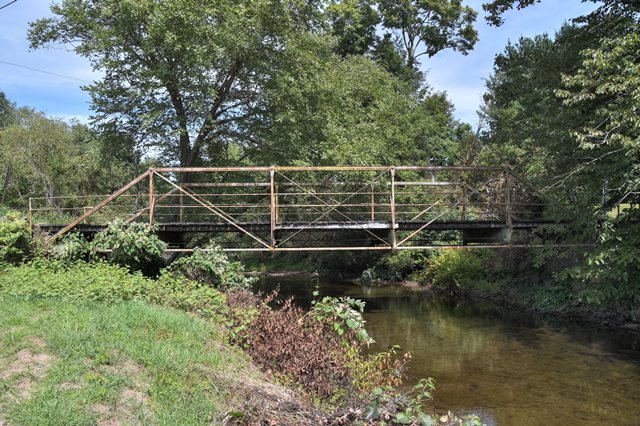We Recommend:
Bach Steel - Experts at historic truss bridge restoration.
BridgeHunter.com Phase 1 is released to the public! - Visit Now
Ftorkowski Road Bridge

Primary Photographer(s): Nathan Holth
Bridge Documented: August 26, 2019
Rural: Luzerne County, Pennsylvania: United States
1889 By Builder/Contractor: Phoenix Bridge Company of Phoenixville, Pennsylvania, Dean and Westbrook of New York, New York, Agents
Not Available or Not Applicable
75.0 Feet (22.9 Meters)
78.0 Feet (23.8 Meters)
15.7 Feet (4.79 Meters)
1 Main Span(s)
24411

View Information About HSR Ratings
Bridge Documentation
This is one of a very rare surviving group of Phoenix column pony trusses all in a single county.
View Archived National Bridge Inventory Report - Has Additional Details and Evaluation
Information and Findings From Pennsylvania's Historic Bridge InventoryDiscussion of Bridge The 5 panel, 78'-long Pratt pony truss bridge is supported on stone abutments. The pin-connected truss tension diagonals are rods, with eyebar bottom chords and Phoenix column top chords. Built-up floorbeams and rolled stringers support the timber deck. Pipe railings are fixed to both trusses. The bridge has been determined eligible by the PHMC. The one span, 78'-long, wrought iron, pin-connected, Pratt pony truss bridge was built by Dean & Westbrook using Phoenix sections for the upper chords and inclined end posts and standard design Phoenix Company connecting pieces and bearings along with details that are particular to Dean & Westbrook. The roadway width is 15’-8”. This is not a standardized design Pratt pony truss bridge, and it represents Dean & Westbrook’s innovative thinking about features intended to provide a stronger bridge with the most economical use of material. The verticals are composed of angles with lacing. Pin plates are used to make their connection at the cast iron upper chord connecting pieces. The deep, built up floorbeams are framed into the bottom portion of the verticals above the eyebar lower chords. There are punched pin holes in each vertical for the lower panel point connection. Placing floorbeams above the lower chords is not common in Pratt pony truss bridges. A triangular-shaped plate riveted to both ends of each floorbeam accommodates connection of an outrigger that meets the vertical at about its midpoint. The diagonals are eyebars, and the counters are bar stock with Dean & Westbrook’s cast open loop heads. The bridge is finished with two lines of pipe railings set in their original cast iron socket fittings and a wood plank deck. It is supported on stone abutments with concrete repairs. Of the several remaining examples of this Dean & Westbrook designed and fabricated Pratt pony truss bridge with the floorbeams above the lower chords, this example is the most historically and technologically significant. The makers plaque documents it to 1889, and it served as the prototype for the other examples, which have variations of the details of this bridge. Dean & Westbrook were the agents marketing and building highway bridges for the Phoenix Iron Company and using Phoenix sections. The company is noted for innovative designs, including at least five remaining examples of this one in Luzerne and Chester (15305200100000) counties and the English Center (Lycoming County) hybrid design placed in 1891. The bridge has high technological significance because of its distinctive details (such as the floorbeam connection, outrigger detail and pin plate connection of the top chord to verticals). representing the era of experimentation in metal truss bridge design and the use of Phoenix sections, which did as much as any detail to prove the value of metal truss bridges during the last half of the 19th century. The cast- and wrought-iron bridge provides an important snapshot of thinking about bridge design and fabrication prior to steel and standardization. All bridges with Phoenix sections have cultural value. The character-defining features include the truss form and method of truss member end connection (pinned Pratt Pony truss), the Phoenix section truss members, the truss to floorbeam connection details (floorbeams framed into the bottom portion of the verticals above the eyebar lower chords and punched pin holes in each vertical for the lower panel point connection) and the outrigger detail (outrigger meets the vertical at about its midpoint). The bridge plaque and bridge railings are also considered significant features. Discussion of Surrounding Area The bridge carries a 2 lane road over a stream in a sparsely developed, rural area with scattered 20th-century residences. The bridge is located on a one lane unimproved road in a rural setting with woodlands, active agriculture and scattered houses. There is an early 19th century house beyond the bridge. The 15’-8” wide bridge roadway is as wide if not wider than the maintained travelway. The bridge and road have a very low reported traffic volume. Bridge Considered Historic By Survey: Yes |
This bridge is tagged with the following special condition(s): Phoenix Columns
![]()
Photo Galleries and Videos: Ftorkowski Road Bridge
Bridge Photo-Documentation
Original / Full Size PhotosA collection of overview and detail photos. This gallery offers photos in the highest available resolution and file size in a touch-friendly popup viewer.
Alternatively, Browse Without Using Viewer
![]()
Bridge Photo-Documentation
Mobile Optimized PhotosA collection of overview and detail photos. This gallery features data-friendly, fast-loading photos in a touch-friendly popup viewer.
Alternatively, Browse Without Using Viewer
![]()
Maps and Links: Ftorkowski Road Bridge
Coordinates (Latitude, Longitude):
Search For Additional Bridge Listings:
Bridgehunter.com: View listed bridges within 0.5 miles (0.8 kilometers) of this bridge.
Bridgehunter.com: View listed bridges within 10 miles (16 kilometers) of this bridge.
Additional Maps:
Google Streetview (If Available)
GeoHack (Additional Links and Coordinates)
Apple Maps (Via DuckDuckGo Search)
Apple Maps (Apple devices only)
Android: Open Location In Your Map or GPS App
Flickr Gallery (Find Nearby Photos)
Wikimedia Commons (Find Nearby Photos)
Directions Via Sygic For Android
Directions Via Sygic For iOS and Android Dolphin Browser
USGS National Map (United States Only)
Historical USGS Topo Maps (United States Only)
Historic Aerials (United States Only)
CalTopo Maps (United States Only)

